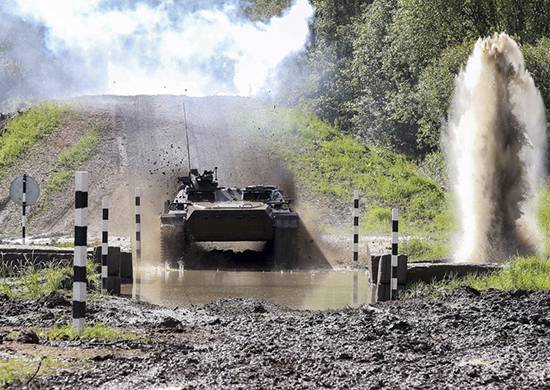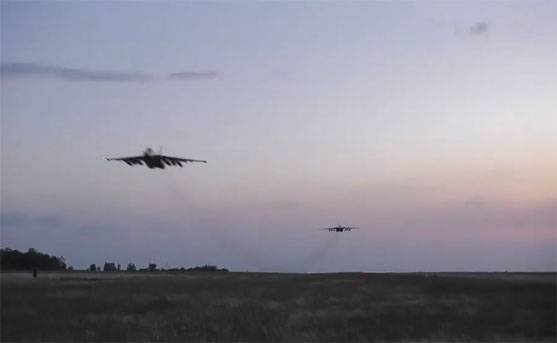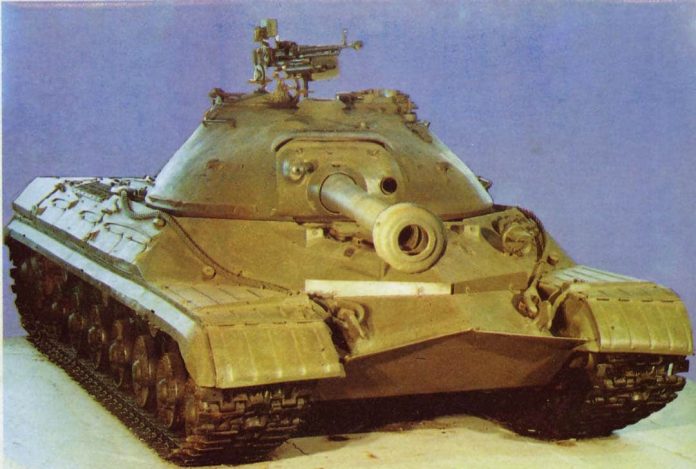
Compared with its coeval - Soviet medium tank T-54, traveled almost half the world, heavy tank T-10, shrouded in secrecy due time (in its construction have been implemented the most advanced at that time, technical solutions), still poorly known to the general public. Yes, and take part in combat operations (which, true, so it can only be called a stretch) T-10 happened only once - at the time of the invasion by the Warsaw Treaty on the territory of Czechoslovakia 1968 year. However, the T-10 was well acquainted NATO generals, who believed, that on the other side of the "iron curtain" over their troops hanging armored fist, with more than 8 thousand. these heavy breakthrough tanks.
Thanks to the efforts of NS. Khrushchev, a big fan of rocketry, T-10 was the last in a series of Soviet heavy tanks production (it was discontinued in production 1965 year, and since then the heavy tanks of the USSR no longer built). Interesting, that "ten" almost became the last in the series of IC brand cars, so named in honor of the "leader of all peoples" - Joseph Stalin. In the course of its development, started in 1948 year, future tank was called IP-8 documents, then 9-IP and, finally, IS-10, but eventually it was adopted under the impersonal designation T-10.
To become more apparent causes of T-10 and its design features, we must recall the situation with the heavy tanks in the Soviet Union after the Second World War. Her battle the Red Army completed, With a significant number of heavy IS-2, Besides, at 1945 year it has been adopted and a new heavy tank IS-3. Unfortunately, soon became clear, EC-3 unsuitable for service in peace time - their reliability and service life of mechanisms proved to be extremely low, whereas in peacetime, the tank had to be operated over the years, and not in a few weeks (before its destruction in battle) - as it was during the war. As a result, already in 1946 , the IS-3 production has been completed, and not having to turn around at full strength, but all have been modernized tanks issued under the program of MCI (eliminating design flaws).
In this way, faced with the task of creating a better heavy tank, in which construction would be considered as accumulated during the fighting experience, as well as the latest achievements of technical thought in the field of tank. This tank has been designed to 1946-1948 years in the Leningrad design bureau under the guidance of M. litter. The machine site-won "260" number and index of IS-7.
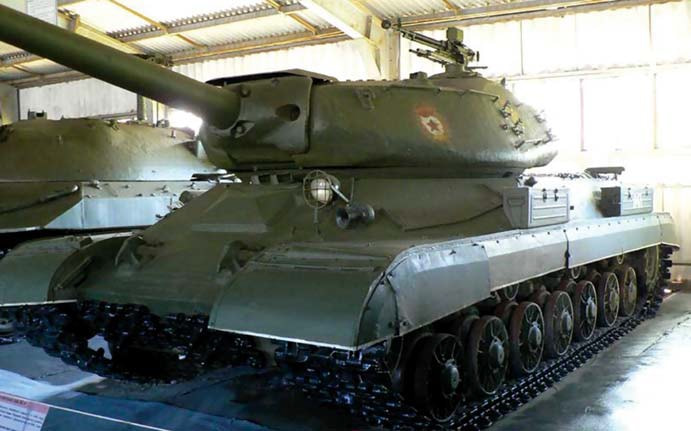 JS-4 Heavy Tank, stored in the Military Historical Museum of Armored Vehicles in Kubinka
JS-4 Heavy Tank, stored in the Military Historical Museum of Armored Vehicles in Kubinka
The designers set out to design a well-armed tank, with heavy armor, able to protect the machine from all available at the moment armed with armor-piercing shells.
During 1948 year at the Kirov plant manufactured four experienced IS-7 sample, that after the factory tests were presented on state tests. but, despite the outstanding performance of IP-7 (none of the contemporary heavy tanks had no such set of core combat capabilities), the machine has not received the approval of the State Commission. In addition to failure during testing, this result was caused by the fundamental shortcomings of the "supertanka", first of all it is too large mass.
Installation of IP-7 heavy-duty artillery armament, which requires the service was a crew of five (which resulted in a significant amount of the reserved tank), and attempt to provide such a large machine the highest level of protection, the then development of technology, led to, her weight reached a record for the Soviet tank 68 t (instead of the planned 65,5 t). But although the IS-7 series has not started, but, working on this project, designers have accumulated rich experience and on later models of Soviet heavy tanks, including in the tank T-10, you can see the many tested for IP-7 units and aggregates.
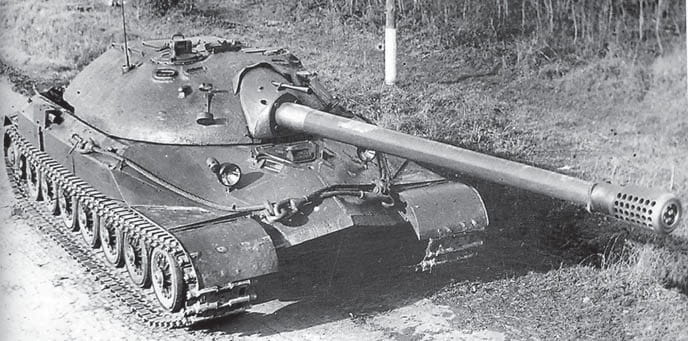 An experienced IS-7 on State Tests
An experienced IS-7 on State Tests
Of overweight was also another Soviet heavy tank - 60-ton IS-4 (developed and launched into production 1947 CHKZ year after discontinuation of the IS-3 here), which for its operation for a short time managed to accumulate a lot of claims on the part of reliability, patency, operational mobility and transportability. Mass and EC-4, and IS-7 exceeded the capacity of most existing at the time of vehicle (railway platforms) and bridges (road bridges of the heavy tank just could not stand).
After the final failure of the IS-7 and stop the production of IC-4 troops were left without promising heavy tank. However, in the "cold war", threatening to go to the "hot", Army urgently needed a new "workhorse" - a heavy machine, surpasses the characteristics of the old tanks of the war years, but at the same time sufficiently reliable, relatively inexpensive and tech, which could be run in production at several factories tank. According to the emerging concept at the time of increasing the role of tanks in a probable nuclear war, It needed to advance the deployment of as many tank units and the production of the greatest possible number of tanks in peacetime, in view of the expected after the nuclear attacks of huge losses in military equipment. So, loss of ground forces in the first two weeks of the war of the future projected in the amount of 30-40%. This concept is consistent with the conclusions, made on the basis of the work of Soviet tank back in 1945-46 years, according to which in peacetime early release of armored vehicles was described as fully justified itself.
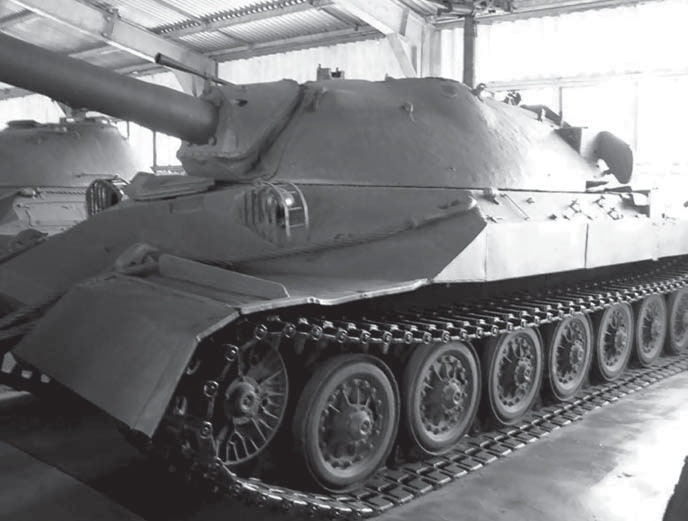 One of the prototypes of the heavy tank IS-7, It is kept in the Military Historical Museum of Armored Vehicles in Kubinka
One of the prototypes of the heavy tank IS-7, It is kept in the Military Historical Museum of Armored Vehicles in Kubinka
The task for such a tank and was issued at the end of HBTU 1948 of the year. Since the main drawback of IP-7 was considered him too much weight, in the terms of reference for a new heavy tank was emphasized, that the weight of the car must not exceed 50 t. She received index IS-8 and object Room - 730, ie. its developer KB Chelyabinsk plant was determined, which was allocated to the "window" site-rates in the range of 700-799. But the chief designer of the tank was appointed F. Kotin, creator of KV tanks and ISov, while working in Leningrad, at the Kirov plant.
This "strangeness" is defined by the time the current situation, when the country was formed two independent centers of development and production of heavy tanks. One in the Urals, where he continued to work Chelyabinsk Tractor Plant (the famous "Tankograd" war years), with the adjusted tank serial production, but with a design office, weakened after returning from evacuation to his native Leningrad a large number of designers. The second - in Leningrad, at the Kirov plant, where tank production after the war and the blockade has not yet been fully restored, but there were large forces designers-tank headed by F. Kotin.
Considering, The new heavy tank was planned to start production not only in Chelyabinsk, but later in Leningrad, It considered important, to designers of both plants took part in its development - the practice showed, that developed on the same basis and under certain production technology the car very difficult to start production at another plant. A significant role in resolving this issue played the then Deputy Chairman of the USSR Council of Ministers in. Malyshev, who throughout the war led by the People's Commissariat of the Tank Industry and knew his business and staff. At his suggestion in 1949 the branch Pilot Plant 100-OGC in Leningrad, whose director is F. Kotin, was reorganized into the All-Union Scientific Research Institute - Research Institute 100. Having the status of the All-Union, This Center has been mandated to conduct the work and make recommendations to the industry-wide tank.
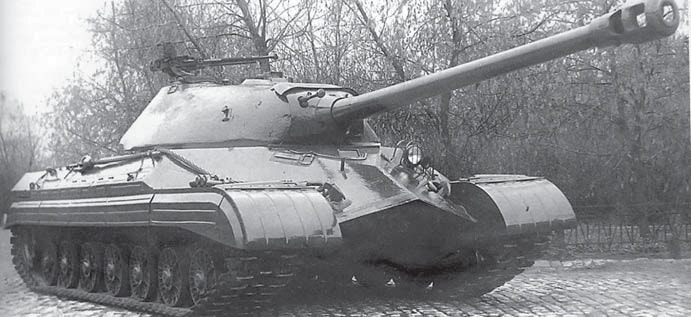 The final version of the prototype heavy tank IS-8 ("Object 730")
The final version of the prototype heavy tank IS-8 ("Object 730")
so, overall management of the project work on the new tank was assigned to F. litter, and direct the project manager was appointed his deputy A. Ermolaev. Develop documentation of a new heavy tank project was decided in Chelyabinsk, for which A. Ermolaev, gathered in Leningrad team of designers, I went with them to Chelyabinsk, where the people of Leningrad were to combine its efforts with the Chelyabinsk Bureau.
Departure from Leningrad was organized, can say, at the state level - for an early train "Red Arrow", sent from Leningrad to Moscow, special wagon was hitched, and in which are located konstruktorytankisty. Upon arrival at the Moscow car attached to the train, next to Chelyabinsk. Here on the station platform designers I met the director CTZ - And. Zalitsman (also a former Leningrad, at 1941 was evacuated here with LB). His efforts newcomers placed in a single at the time around Chelyabinsk hotel "with all the amenities".
Salzman Director and chief designer of factory M. BAL (succeeding transferred to work in the Soviet atomic project N. Pentecost) We tried to organize the work of designers, working on a JS-8, as efficiently as possible, often personally taking part in the discussion of the main provisions of the draft. So, eg, contentious issue, which had to be addressed in the director's office, It was the design of the torsion suspension tank. F. Kotin proposed set of IP-8 already tested on the tank IS-7 torsion beam design, The seven thin rods - the idea was, to make the torsion bars so short, that between them there is sufficient distance to accommodate the motor housing and the other tank arrangements. Thus structure torsionov, apart from the undoubted advantages of layout, It made it possible to maintain the softness of the tank when the suspension drastically reduce the length of the torsion bar. For its part, M. BAL advocated the more simple to manufacture torsion bars monolithic structure.
Since no test benches, to assess the technical characteristics of the two types of torsion bars, at that moment in Chelyabinsk was not and none of the opponents could not present objective evidence of his innocence, the outcome of this heated discussion and summarized. Zalitsman, quipped: "On the one hand the old torsion bar is good because, that he is one and a thick, a new torsion bars - thin and more, they mean bad. But on the other side, can say: look, they are fine, a lot of them and it's very good, and that one, and even thick - it is very bad " (how can not remember P. Kartseva - "... that such cancers, but yesterday ... »). And Director, As an advocate of new technical solutions, I took a volitional decision - take for the project torsion beam. Application of a torsion beam suspension allowed to place the road wheels left and right sides and coaxially leave free suspension components middle portion of the bottom width 460 mm in the entire length of the body. In the vacant space were set engine, rotating tower contact device and the driver's seat. Such space arrangement has reduced the height of the housing and the overall height of the tank.
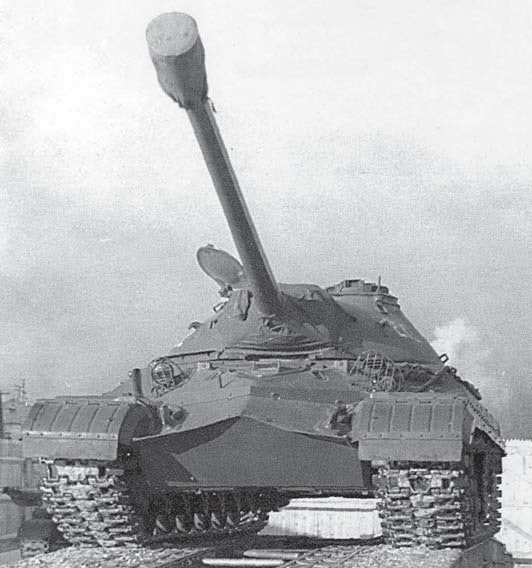 Serial T-10 in the park of a military unit
Serial T-10 in the park of a military unit
Given the strict weight limit (which should not exceed 50 t) on the one hand and the need to ensure a high level of security on the other, designers had to make full use of accumulated over the years of war, the statistics on the susceptibility of individual components of the hull and turret. These data were the basis for developing an effective differentiation booking, which allowed the use of the main mass of armor to protect the most striking parts of the tank, and avoid those parts of overweight and places, shells hit in which were rare.
The configuration of the radome was borrowed from EC-3 tanks and IC-7 ("Pike nose"). armor thickness though it remained the same, as in the IS-3 - 120 mm, but tilted front sheet significantly increased, which improved armor protection frontal part of the housing by increasing the effective thickness of armor. body boards to increase their armor protection have been made components (it went, even though a significant complication of manufacturing technology). The upper part of the bead thickness 120 mm was placed at an angle to the vertical, and the bottom, thickness 80 mm, performed bent, due to this bending of the tank body (in cross-section) extended above the upper branch of the Track - and here formed nadgusenichnye niche. Such a decision although it was technologically difficult (I had to dish out quite thick armor plates), but due to the inclined arrangement of side plates increases the effective thickness of armor, also saves a lot of onboard reservations. Since the effectiveness of on-board reservations was obtained above, than in thin-IS 3, which took on the sides of the armor even greater thickness (90 mm).
Korma IS-8, given the smaller the statistical probability of its defeat, It was made from sheets of thickness 50 mm (Compare: the IS-3 - 60 mm, in IS-4 - 100 mm), but reduction of the thickness of armor designers have tried to compensate for the sheet feed position large slope.
Cast flattened tower, in configuration resembling a JS-3 tower, also received a large structural wall angles and differentiated advanced booking - to 255 mm in front of and around the 40 mm on the roof (where the shells hit were extremely rare).
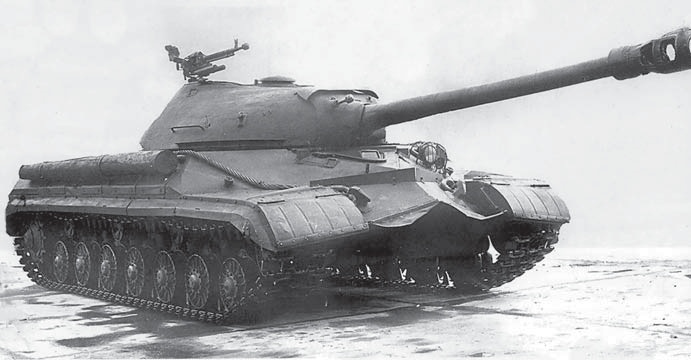
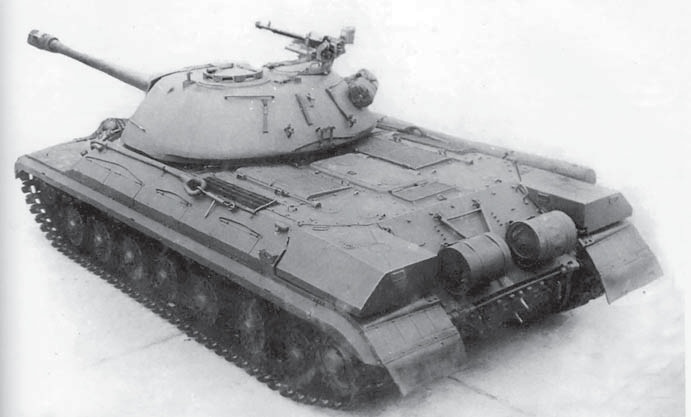
Serial tank T-10 first releases, seen well 122 mm cannon D25- TA with triple muzzle brake, rectangular additional fuel tanks, installed in the aft body, the right to board- matured timber for self
The main armament remained the same, how IP-3, - it was well-deserved 122-mm tank gun D-25, true, several modernized in CDB-9 and get the index of D-25TA. Designers have tried to compensate for its main drawback - low rate, associated with the use of separate loading. Because it practical rate of EC-3 of the tank was only 2-3 shots per minute (and the first shot could be made not less than 20 seconds, Compare: tank "King Tiger" due to the charging of a unitary could produce the first shot after 8 seconds). Charges had to operate in two stages - first from one shell to take boeukladki (weighing more than 25 kg) and shall be sent to him in the bolt stem, then from another boeukladki - sleeve with a charge (weighing about 20 kg) and shall be sent to it after the projectile. The shutter closes automatically, and the gun was ready to fire.
On the new tank shell chambering a special mechanism was provided to increase the rate of gun. Now is charged no longer have to manually shall be sent to the projectile and charge into the bolt of the gun barrel, but only to lay them on a special tray loading rod, disposed laterally from the breech gun. Then the tray is aligned with the bore axis, I turned on the electric chain-loading rod, and projectile "was driven" into the barrel. The same procedure was repeated, and the sleeve, whereby chambering strayed stopper wedge gate: he closed, and the gun was ready to fire. Blagodaryamehanizatsii loading rate of gun D-25TA with the same dimensions and weight of the ammunition has improved in 1,5 fold, to 3-4 rounds per minute (manually when loading rate was 2-3 rds. / min). Sorudiembyl paired magnum (12,7- mm) DSK machine gun. Guidance coaxial machine gun and the horizontal and vertical carried out with a single remote control via TAEN automated electric-1. Commander's cupola for targeting had a tracking device.
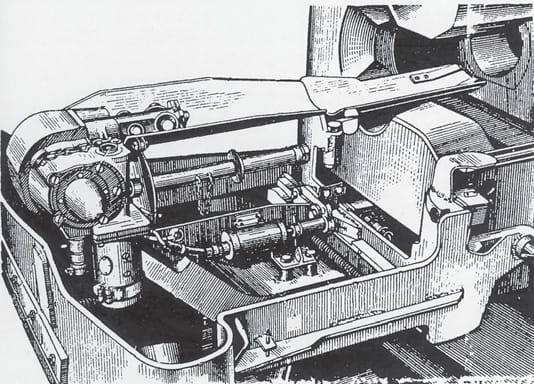 Mechanism chambering shot gun D-25T
Mechanism chambering shot gun D-25T
As the power plant for the new tank was chosen diesel V-12-5, power 700 HP. Cooling system - ejection, held run-in and proven on-7 IC. It was borrowed and successful transmission of EC-7 - eight-gear box with turning mechanism (combined in a single housing) and servo control.
Chassis with seven road wheels and support rollers was similar to the tank IS-4, He borrowed from the caterpillar and the width of the truck 720 mm. Caterpillar provide specific pressure 0,77 kg / cm2 (Compare: in IS-3M - 0,87 kg / cm2 , in IS-4 - 0,92 kg / cm2 ).
This use of well-proven design solutions, as well as the individual has already established and producing standard components and assemblies, allowing you to quickly prepare a draft of the tank - TEHPROEKT JS-8 was prepared in April 1949 of the year. In May of the same year for the mining layout decisions wooden model of the future tank was built in full size, then, making, that all units "in their place", in the experimental shop of the plant started assembling this machine.
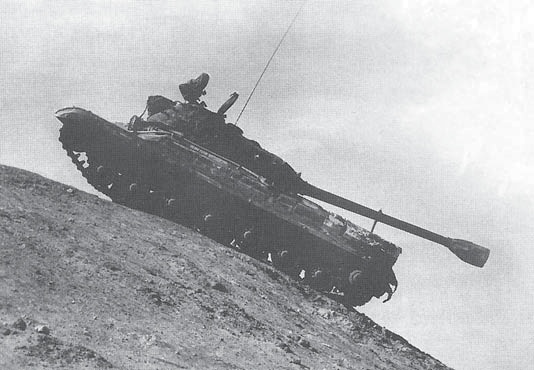 Tank T-10 test overcomes the steep slope
Tank T-10 test overcomes the steep slope
After the factory tests has been ascertained, that experienced the entire machine complies with the requirements specification, and the decision to release the initial batch of 10 tanks. AT 1949 , they passed two stages of production tests, and then in April-May 1950 year were transferred to the state tests, held on NIIBT Polygon Kubinka. According to their results the State Commission recommended that the EC-8 ("Object 730") into production, but only after the completions of MTO, tk. Engine life has been found to be deficient. In accordance with the decision in the summer 1950 of the year, in the harsh conditions of Turkmenistan (Mary city district), performance tests of modified cars on the life of the engine have been conducted, and in the fall and combat tests.
Unfortunately, during the tests revealed, that the initial draft, and consequently, and prototypes, Yet still damp. For their refinement had to perform even a significant amount of various improvements and bug fixes, followed by re-stretched and control tests. As a result of the initial draft has been amended several times, and the tank itself has consistently changed its index - EC-8 EC-9, and then to IC-10. Testing the final version of the machine only ended in December 1952 of the year, and acceptance of the tank into service expected in spring 1953 of the year.
but, in March 1953 of the year, as is known, he died and. Stalin, in whose honor and was at one time accepted abbreviation "IP". In the heat of internal squabbles party leadership and the government it was not until the new tank, this issue returned only after, as the winning group H. Khrushchev managed to arrest and shoot their most dangerous enemy - L. Beria. As a result of the adoption of the tank into service took place only at the end of the year - the Decree of the USSR Council of №2860-1215 28 of November and the Order of Defense №244 15 December, in which he was called is not IS-10, and a T-10.
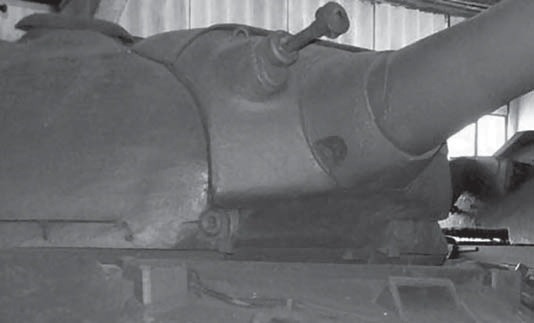 Armor mask orudyya T-10, visible installation of coaxial machine gun DSK
Armor mask orudyya T-10, visible installation of coaxial machine gun DSK
It was the death of the "leader of all peoples", usually, and communicates the fact, that IP-10 was adopted by the Soviet Army (so it was called with 1946 , the Red Army) faceless under the designation T-10. true, also found that statement, according to which even before Stalin's death high guidance recommended not to continue the series of IP tanks. This option is also probable, Considering, what in 1953 by Stalin's authority was still extremely high, and the exposure of the personality cult only began three years later - at the XX Congress of the CPSU. Howbeit, T-10 has received a start in life, and CHKZ started its mass production. true, unfolded it slowly - in 1954 year managed to release only 30 T-10, but in 1955 year there were already built 90.
Apparatus tank T-10
T-10 ("Object 730") I had a complex box-shaped housing with a front part in the form of "pike nose". The sides of the body are components, It consists of upper and lower inclined bent portions. The upper aft housing sheet was made convertible (like T-34) - to provide access to the drive train.
Bottom stamped housing, trough-shaped. Rigidity of the bottom welded prevailed in his rocker arms. To service the units and mechanisms in the bottom holes and hatches were, closed armored caps or stoppers threadedly. Place the driver is ahead on the axis of the machine. For its planting in the tank hatch had a triangular shape, lockable sliding lid. Observation of the terrain a driver drove through the three instruments; one of them - TPR-51 - was placed in the lid of the hatch, Two other type - in the windows of the upper part of the frontal housing.
turret cast, streamlined shape with variable angles of inclination of the walls and of variable thickness - from 250 mm bow to 40 mm on a cast of the roof. The tower was set for a ball bearing on the cut sheet turret roof tank enclosure. The front part of the roof of the tower was cast in concert with the body of the tower, and the back of the armor plate was manufactured and welded to the roof. This sheet was placed on the right charging hatch, which was mounted on the installation of anti-aircraft machine gun. On the left is the door, on which was placed a commander's cupola. In front of the hatch tank commander was TPKU surveillance device, and on the circumference of the overhead turret - seven observation devices TNP. Besides, in the tower were three device TPB-51: one for the gunner and two for charging.
Swing Tower - Planetary, Manual and electric actuators.
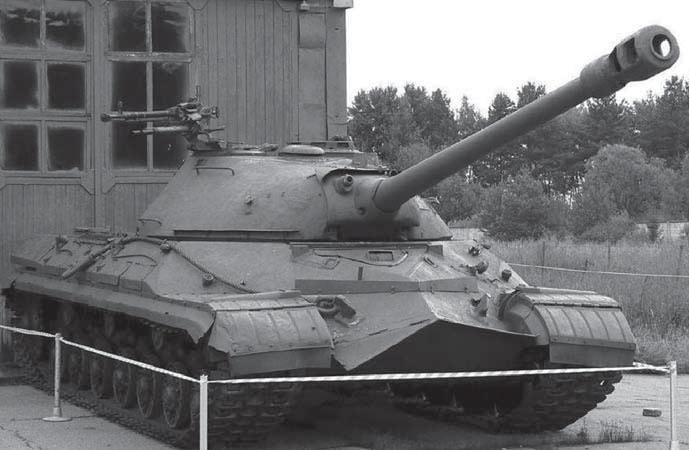 One of the surviving T-10 at the open area of the Military Historical Museum of Armored Vehicles in Kubinka
One of the surviving T-10 at the open area of the Military Historical Museum of Armored Vehicles in Kubinka
The main arms of T-10 were 122 mm tank gun D-25TA with a barrel 48 caliber and coaxial with it 12.7mm gun DShKM, set in a cast mask. The gun had a two-chamber muzzle brake and automatic horizontal wedges. Initial velocity armor-piercing projectile it was 795 m / s. Sighting range using a telescopic sight TSH2- 27 equal 5000 m, and with the help of lateral level - 15000 m. The loading was facilitated by the use of ramming mechanism. Rate in this case was 3-4 rds. / min, and when loading manually - 2-3 rds. / min. On the turret hatch loader installed antiaircraft machine gun 12.7mm DShKM, equipped with a red-dot sight K10-T. Gun ammunition consisted of 30 rounds of separate loading, homutikovyh placed in the gutter and laying. Ammunition consisted of machine guns 1000 rounds, 300 of them to the coaxial machine gun they were placed in six regular ammunition boxes, a 150 to the anti-aircraft guns - three special ammunition boxes. 550 machine-gun ammunition rounds were in the zinc boxes.
The tank was equipped with a diesel engine V-12-5 (12-cylinder, 4-stroke V-shaped cooling liquid, referring to the diesel engines of type B-2) maximum capacity 700 HP. He was placed on a pedestal, consisting of four brackets, welded to the sides and interconnected by longitudinal gons. Starting the engine by the electric type ST 700A or compressed air. Engine cooling system liquid, closed, ejection. The tank had a combined inertial type air purifiers.
The fuel tank system consisted of three internal tank - two rear with a capacity of 185 l and one front - 90 l. All three tanks were connected by pipelines, the front tank is also connected to the injection valve. On the wings in the feed tank was installed on one outer fuel tank capacity of 150 l each. External tanks were connected ktoplivnoy tank system. In this way, the total capacity of all the tanks was 760 l. Since June 1955 Year established internal rear fuel tank capacity 270 l each. Consequently, the total capacity of the tanks has increased to 930 l.
Power transmission consisted of a planetary gearbox in unit with the rotation mechanism of the "ZK", provides eight forward gears and two reverse, and two-stage (with a simple planetary gear and rows) final drives. The main clutch in the classical meaning of the transmission has not been, neutral position in the mechanism of transmission and turns it turned out when you turn off the mechanism of change gears. Front clutch meant only for the reverse gear.
 T-10 at the Museum of military glory, Saratov
T-10 at the Museum of military glory, Saratov
Chassis tank T-10 consisted of a leading location rear wheels, which had a removable crowns 14 teeth. On each side is also aligned on the 7 cast dual rollers with a metallic rim and at three support rollers. tank independent suspension, a sheaf torsion and elastic stop. Torsion beam were 7 rods hex head. Inside the outer rocker suspensions were placed hydraulic shock absorbers double acting. As used podressornikov buffer springs. Caterpillar - Melkozvenchataya, lantern meshing. The number of trucks in each chain - 88. Step Tape - 160 mm, width - 720 mm. single-wire electrical system, 24-volt, It consisted of a generator G-74 and four batteries. For connection on the tank installed radio 10RT-26E and tank intercom TPU-47-2 four subscribers. Also in the carbon dioxide tank it had an automatic system with PPO termozamykatelyami. For dymopuska used two resettable checkers BDSH-5.
T-10A
AT 1950 year in KB Kirov factory (CSC-2, and with 1951 , the Special Design Bureau of tank - OKBT) work began, aimed at increasing the firepower of the T-10 at the expense of stabilization of its arms. This allowed bysuschestvenno raise the probability of hitting the target when firing on the move. The thing is, that since its birth 1916 year and including all the years of the Second World War, dance, to make an aimed shot, I had to stop on the battlefield 2-3 minutes - "shooting with short stops". In these cases, the gunner, detected a, He commanded the driver-mechanic: "Short", and the driver stopped going to attack a tank. Gunner elaborate on a tip-off tools, the shot, and the tank once again moved forward. This firing method reduced the pace attack, increases the residence time of the tank under aimed fire of enemy anti-tank artillery and made him an easy target on the battlefield, because to get in to stop a tank is much easier.
Sometimes, when a particularly high coherence crew, when a driver provided a linear motion of a relatively flat terrain, gunner could make an aimed shot, and without stopping the tank - "shooting on the move". However, statistics show, that in this case, the probability of hitting the target was only 1-2% (one hundred shots fall 1-2). Considering, that most of the ammunition tanks does not exceed 50 shells, it could be considered, that when firing on the move tank, even having shot all their ammunition, could never once did not hit the target.
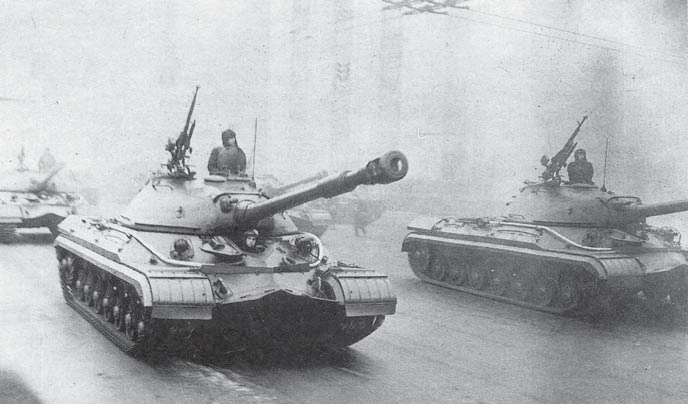 The T-10A at a military parade in Moscow 7 November 1957 of the year. A characteristic feature of the outside of the T-10A was ejector on the gun barrel
The T-10A at a military parade in Moscow 7 November 1957 of the year. A characteristic feature of the outside of the T-10A was ejector on the gun barrel
For T-10 designers considered two arms stabilize embodiment. Origin - precision stabilization of the field of view of the sight and power podstabilizatsiya cannon and tower. Second - power stabilization cannon and tower, in which the tool and rigidly associated sight constantly monitoring purpose. The disadvantage of this solution is that, that when loading, when the gun blocked at predetermined elevation angles, Gunner was deprived of an opportunity to observe the aim of. The first option was deprived of this lack of, which greatly facilitates the work conditions of the gunner, but it was much more difficult to manufacture and operation. Yet it was he who was chosen to stabilize the arms of T-10, and a group of designers OKBT, under the direction of Mr.. Andandonskogo, in cooperation with the Krasnogorsk mechanical plant, Technology developed arms stabilization system design T-10. In the first step proposed to stabilize the arms in a vertical plane, oscillations which have the greatest value to accurately hitting the target.
This stabilization system was tested in a pilot car, registered as "object 267 sp.1 » (the first specification). Lead engineer of this object became Mr.. Andandonskiy. To implement his ideas designers have used a fundamentally new optical periscope-gyroscopic sight TPN-1 (Tank stabilized periscope), wherein one of the mirrors of the periscope stabilized in a vertical plane by means of a gyroscopic device.
Sight tide began on command from the remote control. Tight connection between the sight mirror, and a gun was not, its precise guidance is provided by the operation of the sensor, measured the difference between the angles of sight and gun installations, by which a signal provided electrohydraulic drive current gun aiming. Such a stabilization system called "independent" or "with an independent line of sight". As shown by tests, it was much more effective than "dependent" of the system, later adopted, the middle tank T-54/55, wherein from gyro sensors stabilized instrument, and the sight had with him a rigid mechanical connection (cm. stabilize the second embodiment, above). Besides stabilized sight TPV-1, tank had also duplicate it, normal telescoping, began to TUP.
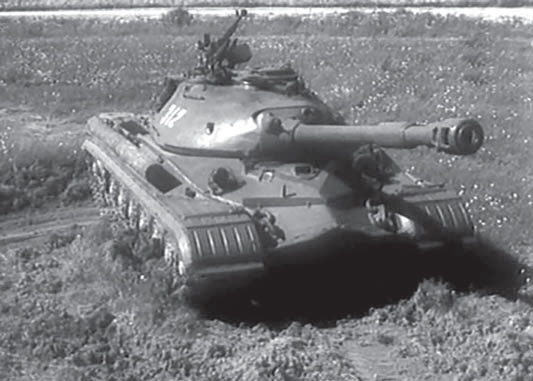 Tank T-10A on the teachings
Tank T-10A on the teachings
Upgrade your weapons D-25TS get change drive for its pairing with odnoploskostnaya stabilizer Puotila-1 "Hurricane". In connection with the installation of the new drive and weapons for a more streamlined body armor has changed the shape of his armor and mask front of the tower. Characteristic external difference gun D-25TS was the presence on the barrel of the ejector (a cylindrical thickening near muzzle brake), which will significantly reduce fumes in the crew compartment at the time of shooting.
In the middle 1955 year produced five samples tank "object at the Kirov plant 267 sp.1 », which had a full test cycle stabilization system main armament.
Tank T-10 with stabilizer arms monoplanar was adopted at the Soviet army service under the designation T-10A Decree of the Government of № 649-378ss 17 May 1956 year and the Order of the Minister of Defense of the USSR 11 June 1956 of the year. In the same year at the Chelyabinsk tractor plant began mass production of such vehicles, received site-room - "730A object". AT 1956 year managed to build 30 T-10A. Simultaneously with the instruments of the stabilization, T-10 was also embedded device night the driver TVN-1 and HPA-48 giropolukompas.








